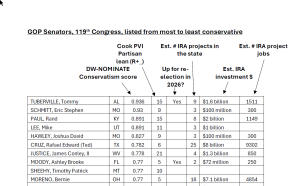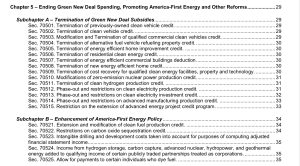The U.S. Senate is currently considering the One Big Beautiful Bill (OBBB). The version passed by the House would drastically scale back the energy infrastructure investment subsidies contained in the 2022 Inflation Reduction Act. The Senate is trying to cobble together a bill that can command 50+ GOP votes (no Democrat will vote for the bill), and seems inclined to enact a softer version than the one passed by the House. Of course, there were similar rumblings before the House vote, but the dissenters all fell in line. (See my prior post about that here.)
The House bill would make electricity from new wind, solar, and and battery investments more expensive by eliminating subsidies for those and other clean energy investments. Sen. Chuck Schumer says that there are 16 Senate Republicans who oppose much of that bill. The Senate Finance Committee released a version of the bill that retains the cuts to renewable energy and EVs, but is less hostile to parts of the IRA that address nuclear power, hydrogen production, and carbon sequestration. The section titles in the committee version tell the story.
But whatever happens in the Senate over the coming weeks, the best way to make sense of it is by focusing on the electoral consequences for individual senators. To put it more simply, the answer to the following question will loom very large in each GOP senator’s decision:
Which is riskier to my re-election prospects: (a) losing jobs and investment money that IRA programs directed to my state, or (b) defying the GOP leadership and President Trump?
As I noted in my earlier post, House Republicans worried more about (b) than (a). How will these cross-cutting pressures play out in the Senate? So far the Senate Finance Committee version looks similar, but with a few concessions not to “jobs in my district” but to types of energy/climate investment many Republicans like — nuclear, hydrogen, etc.
It will be interesting to watch this play out. I have assembled the table below as a sort of GOP senator-specific guide to the various factors that might influence senators’ votes on the bill. Those factors include:
- The senator’s ideological brand – i.e., their conservatism as measured by the DW-NOMINATE database.[i]
- How safe the senator’s seat is for their party, as measured by the Cook Political Report PVI score for the senator’s state.[ii] A Cook PVI score of D+2, for example, means that in the 2020 and 2024 presidential elections, the state performed about two points more Democratic in terms of two-party vote share than the nation did as a whole.
- Whether the senator is up for re-election in 2026.
- One consultant’s estimates of the number of IRA-generated projects, size of their total dollar investment, and the number of jobs associated with those investments, broken down by state.[iii] These estimates are somewhat outdated, but the more recent DOE numbers have been removed from the DOE web site. So these were the best I could find. We can use them as a (good enough) proxy for the relative benefits being captured by each state.
Click on the table to enlarge it.
You can use the table to think about the politics of passing whatever version of the bill comes to the Senate floor. More often than not, senators representing safe seats bend to the will of the primary voters who control their destiny. But not all of them represent safe seats, and not all are equally conservative.
I have highlighted in the table the four senators who signed the letter to Majority Leader Thune opposing a general repeal of the IRA back in April. Notice that the four are among the least conservative members of their party caucus. Not coincidentally, only one represents a state with a PVI score greater than R+10. However, only Sen. Tills (NC) is up for re-election in 2026. And Tillis’ home state is one of only two states estimated to receive more than $10 billion in energy investments and more than 10,000 jobs from the IRA (see table).
If the bill is weakened, we may never know which senators elicited which changes in the House bill to make it palatable to at least 50 senators. If the Senate bill repeals less of the IRA than the House bill, then the bill goes back to the House. That will once again pit House Republicans who favor retaining much of the IRA against the most conservative members of the House GOP caucus (who prevailed in the first vote). Get your popcorn ready. — David Spence
———————————-
[i] Lewis, Jeffrey B., Keith Poole, Howard Rosenthal, Adam Boche, Aaron Rudkin, and Luke Sonnet (2025). Voteview: Congressional Roll-Call Votes Database. https://voteview.com/. These scores are from the DW-NOMINATE data set’s measure of conservatism on regulatory/economic issues. A higher number denotes more conservatism.
[ii] Cook Political Report, 2025 PVI Scores, available (to paid members) at cookpolitical.com.
[iii] These data are estimates derived in August of 2024 by the consulting firm E2, and available at https://s3.documentcloud.org/documents/25042572/e2-clean-economy-works-ira-two-year-review_august-2024.pdf.






